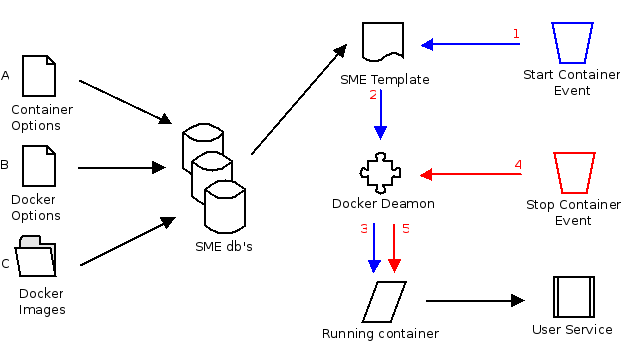Docker design concept
Purpose
This page holds a conceptual design for Docker on SME Server. See more details on Docker here
Overview
Design principles
- This design concept only addresses demonized containers and not interactive containers.
- This design only addresses containers that hold application(s) for end users. Not for sys admins.
- Transparent 'Click to run' user experience
- No integration with Server Manager (Yet).
- Full integration in SME Sever templating system and SME Server db databases
- Pre-build images are not available yet
- No build-in pre-checks regarding starting a container and server capacity
- The design is intended for a single SME Server host, not a cluster or a farm.
- May not effect or compromise default SME Server functionality, stability and security
Options
This document does not address any integration with Server Manager. All input is to be considered a flat file or manual db entries.
A. Container Options
Start
The docker client can be invoked with various flags and arguments. These flags and arguments are past to the docker daemon to construct the docker container and run it. To see all docker client command execute:
docker
To see all available arguments, execute
docker -h
B. Docker options
- TBA
C. Image options
- Linked containers
SME Databases
Container options
Syntax:
db docker_containers [name]
Key:
docker_containers [name]=service
Types:
| status | enabled / disabled |
| TCPPort | n , n |
| UDPPort | n , n |
| PortMapping | native / custom |
| PortMappingPorts | n:n , n:n |
| access | private / public |
| network | bridge / host |
| MountPath | path , path |
| Interlinked | [alias] |
| InterLinkPriority | n |
| MaxMemory | n |
| SubDomain | enabled / disabled |
| SubDomainName | name |
| WebAlias | name |
| DataMount | container / host |
| DataMountWrite | yes / no |
| DataMountPath | path |
Image options
Syntax:
db docker_images
Key:
docker_images [name]=service
SME Template/fragments
- TBA
Start/Stop events
- Manual on console
- Time based by cron
- Triggered by an event
Create a SME docker Base image
WIP --Stephdl (talk) 15:56, 15 September 2014 (MDT) Install docker to your sme, be aware that you have to do it on a 64 bit
Create your repository file and save it to /root/repo_file
#------------------------------------------------------------ # !!DO NOT MODIFY THIS FILE!! # # Manual changes will be lost when this file is regenerated. # # Please read the developer's guide, which is available # at http://www.contribs.org/development/ # # Copyright (C) 1999-2006 Mitel Networks Corporation #------------------------------------------------------------ [base] enabled=1 mirrorlist=http://mirrorlist.centos.org/?release=6&arch=x86_64&repo=os name=CentOS - os gpgcheck=0 enablegroups=1 exclude=initscripts libgsf [centosplus] enabled=0 mirrorlist=http://mirrorlist.centos.org/?release=$releasever&arch=$basearch&repo=centosplus name=CentOS - centosplus gpgcheck=0 enablegroups=0 [contrib] enabled=0 mirrorlist=http://mirrorlist.centos.org/?release=$releasever&arch=$basearch&repo=contrib name=CentOS - contrib gpgcheck=0 enablegroups=0 [extras] enabled=0 mirrorlist=http://mirrorlist.centos.org/?release=$releasever&arch=$basearch&repo=extras name=CentOS - extras gpgcheck=0 enablegroups=0 [fasttrack] enabled=0 mirrorlist=http://mirrorlist.centos.org/?release=$releasever&arch=$basearch&repo=fasttrack name=CentOS - fasttrack gpgcheck=0 enablegroups=0 [smeaddons] enabled=1 mirrorlist=http://mirrorlist.contribs.org/mirrorlist/smeaddons-9 name=SME Server - addons gpgcheck=0 enablegroups=1 [smecontribs] enabled=0 mirrorlist=http://mirrorlist.contribs.org/mirrorlist/smecontribs-9 name=SME Server - contribs gpgcheck=0 enablegroups=1 [smedev] enabled=0 mirrorlist=http://mirrorlist.contribs.org/mirrorlist/smedev-9 name=SME Server - dev gpgcheck=0 enablegroups=1 [smeextras] enabled=1 mirrorlist=http://mirrorlist.contribs.org/mirrorlist/smeextras-9 name=SME Server - extras gpgcheck=0 enablegroups=1 [smeos] enabled=1 mirrorlist=http://mirrorlist.contribs.org/mirrorlist/smeos-9 name=SME Server - os gpgcheck=0 enablegroups=1 [smetest] enabled=0 mirrorlist=http://mirrorlist.contribs.org/mirrorlist/smetest-9 name=SME Server - test gpgcheck=0 enablegroups=1 [smeupdates] enabled=1 mirrorlist=http://mirrorlist.contribs.org/mirrorlist/smeupdates-9 name=SME Server - updates gpgcheck=0 enablegroups=1 [smeupdates-testing] enabled=0 mirrorlist=http://mirrorlist.contribs.org/mirrorlist/smeupdates-testing-9 name=SME Server - updates testing gpgcheck=0 enablegroups=1
[updates] enabled=1 mirrorlist=http://mirrorlist.centos.org/?release=6&arch=x86_64&repo=updates name=CentOS - updates gpgcheck=0 enablegroups=1 exclude=initscripts libgsf
- first create a file and record the content
vim /root/docker_images
#!/usr/bin/env bash
#
# Create a base CentOS Docker image.
#
# This script is useful on systems with yum installed (e.g., building
# a CentOS image on CentOS). See contrib/mkimage-rinse.sh for a way
# to build CentOS images on other systems.
usage() {
cat <<EOOPTS
$(basename $0) [OPTIONS] <name>
OPTIONS:
-y <yumconf> The path to the yum config to install packages from. The
default is /etc/yum.conf.
EOOPTS
exit 1
}
# option defaults
yum_config=/etc/yum.conf
while getopts ":y:h" opt; do
case $opt in
y)
yum_config=$OPTARG
;;
h)
usage
;;
\?)
echo "Invalid option: -$OPTARG"
usage
;;
esac
done
shift $((OPTIND - 1))
name=$1
if -z $name ; then
usage
fi
#--------------------
target=$(mktemp -d --tmpdir $(basename $0).XXXXXX)
set -x
mkdir -m 755 "$target"/dev
mknod -m 600 "$target"/dev/console c 5 1
mknod -m 600 "$target"/dev/initctl p
mknod -m 666 "$target"/dev/full c 1 7
mknod -m 666 "$target"/dev/null c 1 3
mknod -m 666 "$target"/dev/ptmx c 5 2
mknod -m 666 "$target"/dev/random c 1 8
mknod -m 666 "$target"/dev/tty c 5 0
mknod -m 666 "$target"/dev/tty0 c 4 0
mknod -m 666 "$target"/dev/urandom c 1 9
mknod -m 666 "$target"/dev/zero c 1 5
#yum -c "$yum_config" --installroot="$target" --setopt=tsflags=nodocs \
#--setopt=group_package_types=mandatory -y groupinstall Core
#yum -c "/root/repo_file" --installroot="$target" --setopt=tsflags=nodocs --setopt=group_package_types=mandatory -y groupinstall Core ###this line is to test and build a pure centos base in order to test
yum -c "/root/repo_file" --installroot="$target" --setopt=tsflags=nodocs --setopt=group_package_types=mandatory -y install --disablerepo=* --enablerepo=smeos,smeextras e-smith\* smeserver\*
yum -c "/root/repo_file" --installroot="$target" -y clean all
cat > "$target"/etc/sysconfig/network <<EOF
NETWORKING=yes
HOSTNAME=localhost.localdomain
EOF
# effectively: febootstrap-minimize --keep-zoneinfo --keep-rpmdb
# --keep-services "$target". Stolen from mkimage-rinse.sh
# locales
rm -rf "$target"/usr/{{lib,share}/locale,{lib,lib64}/gconv,bin/localedef,sbin/build-locale-archive}
# docs
rm -rf "$target"/usr/share/{man,doc,info,gnome/help}
# cracklib
rm -rf "$target"/usr/share/cracklib
# i18n
rm -rf "$target"/usr/share/i18n
# sln
rm -rf "$target"/sbin/sln
# ldconfig
rm -rf "$target"/etc/ld.so.cache
rm -rf "$target"/var/cache/ldconfig/*
#version=
if [ -r "$target"/etc/redhat-release ]; then
version="$(sed 's/^[^0-9\]*\([0-9.]\+\).*$/\1/' "$target"/etc/redhat-release)"
fi
if [ -z "$version" ]; then
echo >&2 "warning: cannot autodetect OS version, using '$name' as tag"
version=$name
fi
tar --numeric-owner -c -C "$target" . | docker import - $name:$version
docker run -i -t $name:$version echo success
rm -rf "$target"
give the permissions to the file
chmod u+x /root/docker_images
and launch the script
/root/docker_images [name_of_your_image]
